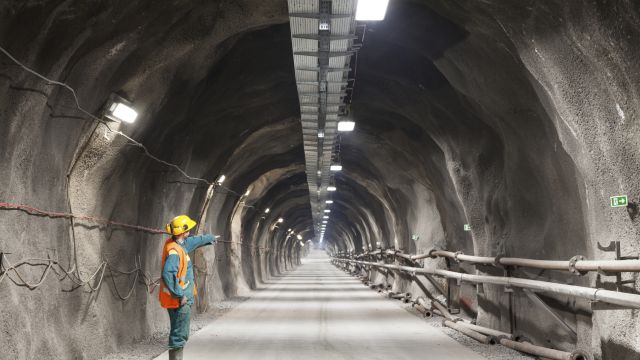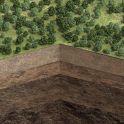
Tools for the safety assessment of repositories
Whether or not a repository for radioactive waste will be safe in the long run depends on the influence of different factors. For researchers in this field it is above all interesting to find out how and in which way radioactive materials can reach into the environment. This can happen in different ways. For example, the radioactive substances can dissolve in water or gases and reach the earth’s surface. Gases will form e.g. upon the corrosion of waste containers or the decomposition of organic substances (e.g. from medical applications). Furthermore, there may be water present in the rock, having been enclosed there for millions of years. These solutions are limited in their amount and mostly unproblematic. If, however, the water does not originate from the rock formation itself but flows in from outside ‒ e.g. from an aquifer ‒ it may cause problems.
GRS studies the transport of radionuclides in repositories
In its most recent research project, GRS is studying the movement of water and gas - and the radioactive materials contained therein - in repositories. The aim of the new study is to refine the calculation tools for the safety assessment of repositories. The study is funded by the Federal Environment Ministry.
The experts use the computer model for the repository to calculate the transport behaviour of the radioactive materials in water and gas by means of the so-called two-phase flow. The term two-phase flow refers to the simultaneous flow of two immiscible fluids – e.g. water and gas – e.g. in a rock pore. To calculate this complicated process, GRS applies the TOUGH2 (Transport of Unsaturated Groundwater and Heat) code. This code was developed at the Lawrence Berkeley National Laboratories in the United States. It can be used for modelling the transport of radionuclides contained in solutions and gases through rock. TOUGH2 is not only used in connection with repository research but also in other industrial areas, such as the oil and gas industries.
GRS has been using and optimising TOUGH2 for more than twenty years. The code is currently being used amongst other things for the calculation of thermal-hydraulic, mechanical and chemical processes – or in short THMC processes – in the transition phase of a repository. The transition phase is what the researchers refer to when they speak about the first 10,000 years following the emplacement of the radioactive waste. This is the period in which gas formation processes are particularly relevant.
Test on a real repository site
Despite the fact that there is long-standing experience with two-phase flow models, they are only rarely used. For future analyses ‒ e.g. in the site selection process – it will be necessary to test this approach additionally using the example of a real site. Consequently, GRS uses the data from the Morsleben Repository for Radioactive Waste (ERAM) for its project in order to be able to test the code. In this former potash and salt mine, there are at present about 36,754 cubic metres of low- and medium active waste emplaced.
Project highlights Disposal

Germany is searching for a site for a repository for high-level radioactive waste. According to the Site Selection Act, the site with the best-possible safety is be found by means of a comparative procedure. But how can the requirements of the law be transformed into concrete scientific requirements? Together with other institutions, GRS researchers now present a first approach.